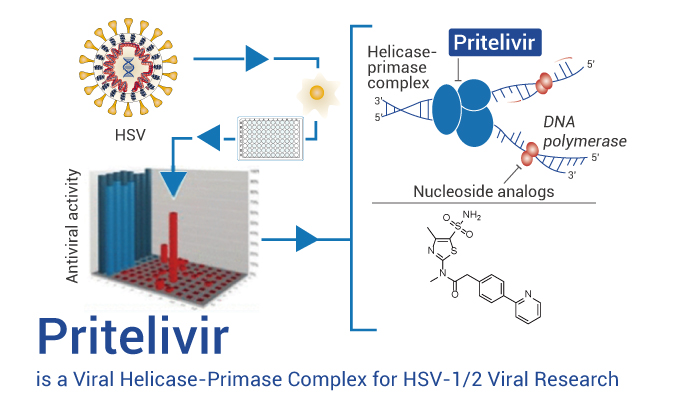Herpes simplex virus 1 and 2 (HSV-1 and HSV-2) are two members of the human Herpesviridae family, a set of viruses that produce viral infections in the majority of humans. Both HSV-1 and HSV-2 are very common and contagious. HSV can be spread when an infected person is producing and shedding the virus. Herpes simplex can be spread through contact with saliva, such as sharing drinks. Symptoms of herpes simplex virus infection include watery blisters in the skin or mucous membranes of the mouth, lips or genitals. Lesions heal with ascab characteristic of herpetic disease. As neurotropic and neuroinvasive viruses, HSV-1 and -2 persist in the body by becoming latent and hiding from the immune system in the cell bodies of neurons. After the initial or primary infection, some infected people experience sporadic episodes of viral reactivation or outbreaks.
Pritelivir is a Viral Helicase-Primase Complex for HSV-1/2 Viral Research
Pritelivir (AIC316) is an inhibitor of the viral helicase-primase complex. And it exhibits antiviral activity in vitro and in animal models of herpes simplex virus (HSV) infection. Pritelivir is active against herpes simplex virus types 1 and 2 (HSV-1 and HSV-2) with the IC50 of 0.02 μM against HSV1-2.
In Vivo, Pritelivir is the first in a class of antiviral agents that inhibit HSV replication by targeting the viral helicase-primase enzyme complex. And Pritelivir (0.03-45 mg/kg) significantly increases survival. Moreover, Pritelivir (0.3-30 mg/kg) reduces mortality against HSV-1, E-377. Pritelivir has potent and resistance-breaking antiviral efficacy with potential for the treatment of potentially life-threatening HSV type 1 and 2 infections, including herpes simplex encephalitis. Combination therapies of Pritelivir at 0.1 or 0.3 mg/kg/dose with Acyclovir (10 mg/kg/dose) are protective when compared to the vehicle treated group against HSV-2, strain MS.
In conclusion, Pritelivir is a Viral Helicase-Primase Complex for HSV-1/2 Viral Research.
Reference:
[1]. Front Microbiol. 2018 Oct 23;9:2483.
[2]. N Engl J Med. 2014 Jan 16;370(3):201-10.
[3]. Antiviral Res. 2018 Jan;149:1-6.
